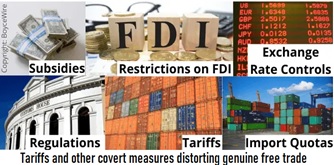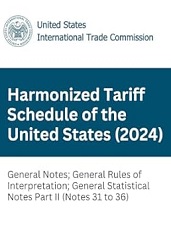The grave error of widespread protectionism.
There is no doubt that the United States has been experiencing for decades the problem of an overwhelming trade deficit with almost all countries in the world,  especially with China. It is a disastrous reality that has been getting worse year after year and reveals the covert policy of those countries that have abused tariffs, subsidies, and low wages to make US goods less competitive. Eventually, they managed to dismantle entire industries whose entrepreneurs had gone bankrupt or fled to countries that unilaterally promoted their competitive advantages against this country.
especially with China. It is a disastrous reality that has been getting worse year after year and reveals the covert policy of those countries that have abused tariffs, subsidies, and low wages to make US goods less competitive. Eventually, they managed to dismantle entire industries whose entrepreneurs had gone bankrupt or fled to countries that unilaterally promoted their competitive advantages against this country.
Intending to partially remedy this problem, the tax reduction for many of these industries that was applied during the previous administration of President Trump, achieved the return of many of these producers to resume their activities in the United States. It was a successful measure that should continue to be promoted in the current administration.
On the contrary, the measure promised during the campaign and now in the process of being implemented, which would impose 10% tariffs on the import of all products from those countries that have enjoyed abusive trade advantages for so long, is a serious mistake that will not only foment a disastrous trade war but, far from alleviating the tax burden suffered by the inhabitants of this country, actually represents a deceptive 10% tax on both consumers of manufactured products and producers and entrepreneurs who import from those countries the raw materials essential for the production of their products.
President Trump has boasted that countries that abuse our indifferent trade policy will thus be paying a tax that can be subtracted from the tax burden on the inhabitants of the country. One wonders if any economist could have advised him to make such a blunder. If so, he is an impostor economist.
Tariffs are not paid by exporters in the country to which the tariff is applied. Tariffs on Chinese products, for example, are not paid by Chinese companies; they are paid by importers who do business with China. To be precise, the importer of record who must pay the tariffs can be the buyer or his customs broker partner, but whoever it is, if a tariff is due and you initiated the import procedure, the funds will come from you. In fact, it is a tax levied on consumers, businesses, and producers in the importing country.
This means that a universal tariff of 10% will proportionally increase the price of all imported products made by the exporting country. Worse still, when what is imported is a commodity or an unfinished product, the industrial entrepreneur who imports it to make his products in the United States will surely increase the price by more than 10% to make some profit from the additional cost of import.
So, basically: if you import a good or product that is subject to tariffs, you are the one who pays it to Customs or border controls directly or indirectly. That's it! Country-of-origin tariffs mean that US importers bear their cost and consumers and producers pay for them.
On the other hand, it is a fact that the US already has a tariff system. But these are selectively applied. Only about 30% of imports to the US are subject to tariffs these days. 
The Harmonized Tariff Schedule of the United States is a list of tariff codes for everything imported into the US, which are often hyper-specific, and customs duties can change concerning different codes. Artificial plastic flowers, for example, have a different rate than natural flowers, while human hair has virtually no tariff at all despite having a tariff code. Having an entry in the Harmonized Tariff Schedule does not mean that tariffs have to be paid in all cases but in specific cases.
Free trade agreements, such as the Korea-United States Free Trade Agreement (KORUS), ensure that tariffs remain outside modern international trade. Under KORUS, 95% of tariffs on goods between the two countries have been eliminated. Other free trade agreements with Canada, Mexico, and elsewhere operate in a similar way.
The universal 10% tariff is therefore a serious mistake. If a trade war is considered necessary in the face of an abusive relationship with the exporting country, it would be acceptable to be selective with adversaries such as China, but not with friendly countries with which negotiations are possible while applying measures to attract producers to the USA, eliminate the heavy regulatory burden that weighs down many industries (one of Trump's promises) and reduce tax rates to competitive levels for US-based corporations (another of his promises).
It is essential that Trump be well advised on this issue and reconsider it in time. Starting a trade war with the rest of the world can lead to disaster.
Comments powered by CComment